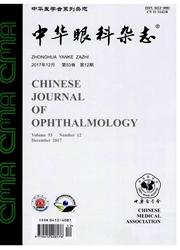

 中文摘要:
中文摘要:
目的 通过豚鼠视动反应来测量分析其条栅视力.方法 实验研究.根据视动性头部震颤反应的原理,豚鼠被单独放置在直径为130 cm的转鼓中央,转鼓内壁贴有可以更换空间频率和对比度的方波条栅.测量之前在豚鼠头部贴一小纸板,上面印有两个小白点,自行编写的测量软件通过追踪小白点的运动来记录头部的追随运动.两个小白点之间的相对位置关系被定义为头转动的角速度,而头转动的角速度与鼓转动的角速度的比值定义为"头部运动反应率".取相同年龄不同屈光状态(+9.70~-15.00 D)的豚鼠11只,比较其对0.6周/度和2.4周/度的条栅的反应;取相同屈光状态,不同年龄(1~3月龄)的豚鼠17只,测量其对不同级别条栅的反应;取相同年龄相同屈光度的豚鼠3只,在不同环境照度(10、30和350 cd/m2)下测量其对级别为0.6周/度而对比度不同(25%、50%和100%)的条栅的视动性反应.不同年龄段豚鼠各级条栅视力的比较用单因素方差分析;各种环境照度下不同对比度条栅之间的视动性反应的比较,以及不同屈光度组别豚鼠的视力比较,均用非参数检验中的Kruskal-Wallis检验法.结果 自制视力仪可以在豚鼠双眼开放状态下有效而快速的测量其单眼视力;而且可以敏感的检测出不同屈光不正豚鼠的视力差别;不同月龄豚鼠,随年龄增加,对各条栅的视动反应逐渐明显稳定,年龄小的豚鼠(1月龄)与较年龄大的豚鼠(2,3月龄)的视动性头部追随运动反应明显低,差异有统计学意义(F=35.73,P<0.001).2月龄豚鼠,测试其0.6周/度空间频率的条栅,对于三个不同对比度的条栅,其视动性反应的最大斜率均出现在照明度为30 cd/m2时,分别为0.70±0.10(25%)、0.94±0.16(50%)和0.95±0.20(100%).在3种照明度下,对对比度为100%的条栅的头部视动性反应率最大,分别为0.81±0.25(10 cd/m2)、0.95±0.20(30 cd/m2)、0.8
 英文摘要:
英文摘要:
Objective The guinea pig becomes an important model for studies on myopia, but little is known about its visual performance. In this study, grating acuity was measured using a custom-built automated device to track optomotor responses. Methods To record head nystagmus, guinea pigs were individually placed in the center of a rotating drum of 130 cm diameter. The drum was covered inside with square wave gratings of adjustable fundamental spatial frequencies and contrast. The turning movements of the head were tracked using custom-written video software that detected two little white spots painted on a small black piece of cardboard that was attached to the guinea pig' s head. Angular head speed was determined from the positions of the two white spots with respect to each other over time, and the ratio of angular head speed to drum speed was determined (the " gain" ). In 11 guinea pigs of the same age, but with different refractive states ( +9. 7 to -15. OD), responses to spatial frequencies of 0. 6 and 2. 4 cyc/deg were tested. Furthermore, 17 guinea pigs were tested which had similar refractive states but were different in age (1 to 3 months old). Finally, the effects of different grating contrasts were studied (25% , 50% and 100% contrast respectively) and the effects of different stripe luminances ( 10, 30, and 350 cd/m2 respectively). Results The optomotor response could be used to measure vision in one eye only even if both eyes opened. The optomotor gain was affected by refractive error. Younger animals (one month old) had lower optomotor gain than older ones (0. 61 ±0. 2 in one-month, 0. 77 ±0. 13 in two-month and 0. 80 ±0. 11 in three-month old). For a spatial frequency of 0. 6 cyc/deg, the effects of stripe contrast were tested in two months old guinea pigs. At an average stripe luminance of 30 cd/m2, the optomotor gain dropped from 0. 95± 0. 20 at maximal contrast, to 0. 94 ± 0. 16 at 50% contrast, and 0. 70 ± 0.10 at 25% contrast At three different luminances, ga
 同期刊论文项目
同期刊论文项目
 同项目期刊论文
同项目期刊论文
 Axial myopia induced by hyperopic defocus in guinea pigs: A detailed assessment on susceptibility an
Axial myopia induced by hyperopic defocus in guinea pigs: A detailed assessment on susceptibility an Axial myopia induced by a monocularly-deprived facemask in guinea pigs: A non-invasive and effective
Axial myopia induced by a monocularly-deprived facemask in guinea pigs: A non-invasive and effective Biometric measurement of the mouse eye using optical coherence tomography with focal plane advanceme
Biometric measurement of the mouse eye using optical coherence tomography with focal plane advanceme 期刊信息
期刊信息
